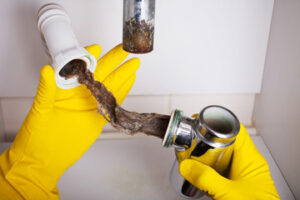Drain Cleaning: How to Get Rid of Clogged Drains
Foul odors from drains can indicate a deeper issue that requires professional drain cleaning. Using DIY drain cleaners at can damage your pipes and lead to costly repairs.
Soap scum, grime, hair products, and toothpaste particles build up over time and clog your drains. Annual drain cleaning can prevent these problems.
Salt is a common ingredient in kitchens, and it has many other uses, including unclogging drains. When mixed with hot water, it acts as a natural scouring agent to scrub away the buildup that causes clogged pipes. It is most effective on a grease or soap clog because it dissolves the fats and oils that build up inside the pipes.
This method is quick and inexpensive, and it can be used in almost any type of plumbing. However, it is not suitable for plastic pipes because the high temperature of the boiling water can cause them to crack or leak. This technique may not work well on very deep or stubborn clogs, but it is a good first step to try before moving on to other options.
Another popular method for unclogging drains is to use baking soda and vinegar. This combination is very effective for hair, soap scum, and grease blockages. The solution is simple to prepare: pour one-half cup of baking soda into the clogged drain and immediately follow it with one-half cup of white vinegar. The mixture will bubble and fizz, loosening the clog and flushing the pipes. It is important to use vinegar rather than a mineral solvent such as turpentine because it is less damaging to the pipes.
A similar drain cleaning recipe is to mix liquid dish soap with boiling water. This combination is very effective at breaking up fatty acids, which make up most of the substances that create FOG clogs. The soap will dissolve the greasy residue, and the hot water will melt it and flush it away. This method is especially helpful for sinks and garbage disposals in kitchens.
Be careful when using this method because the hot water could damage or break down PVC pipes. It is also a bad idea to use this method on a septic system, as the high concentration of sodium can harm or even kill off the bacteria that break down waste in the tank. This can lead to a buildup of solids in the tank and potentially a failure of the system.
Plunger
A plunger is a basic household tool designed to deal with drain clogs. It consists of a rubber cup attached to a stick with an adjustable handle that can be manipulated up and down to create suction and pressure, which can dislodge even the toughest clogs. There are many different types of plungers and sizes of cups, but they all work the same way. The handle should be firmly gripped and plunged up and down quickly.
Before plunging, it’s important to make sure the cup of the plunger is sealed tightly over the drain opening. To do this, put some petroleum jelly on the rim of the plunger. This will seal it over the drain and prevent air from escaping during the plunge. Then, firmly plunge the drain up and down 15 to 20 times. If the clog has been broken up by the suction and pressure of the plunger, the water should drain away shortly after.
Using the plunger is an affordable, effective, and environmentally friendly solution to drain problems. Unlike commercial drain cleaners, it also does not leave any dangerous chemicals behind to corrode pipes or cause harm to skin, eyes, or lungs. It’s a good idea to keep a plunger or two handy in the closet for emergencies.
George Medina, a plumber and National Technical Institute instructor, recommends using the plunger before resorting to more expensive, chemical-based products to clear a sink, tub, or toilet drain. According to him, one of the biggest complaints he hears from homeowners is that chemical cleaners don’t always work.
The proper technique for plunging a bathtub or sink is to fill the tub or sink with about an inch of hot water. Make sure the water is running while you do this. Then, position a towel over the drain to catch any water splashing back into the room. Next, wet a clean cloth and place it over the hole in the drain. This will help keep any hair or other debris from falling into the drain while you plunge.
To plunge a bathtub or sink, hold the handle of the plunger about an inch above the drain opening. Then, thrust the plunger with quick, concentrated thrusts without lifting it high enough to break the seal. Do this for about twenty seconds, and then pull the plunger away. Repeat this process if necessary to dislodge the clog.
Bio-Clean
Bio-Clean is a safe and effective natural drain cleaner. It contains a special blend of enzyme-producing bacteria that digest organic waste found in drain lines. The bacteria feed on the grease, soap film, hair, paper, and cotton that accumulate in your pipes and cause slow or clogged drains.
The minute Bio-Clean comes in contact with water, it begins consuming the waste and transforming it into mineral ash and carbon dioxide. Unlike other drain cleaning chemicals that attack everything in their path, Bio-Clean targets only the organic waste causing the blockage. This eliminates the need to use harsh and toxic chemicals that damage your pipes and leave corrosive residue.
While conventional and household chemical drain cleaners are incredibly toxic to the environment, all natural Bio-Clean products are safe for everyone, pets, and plants. Bio-Clean also eliminates odors without any chemicals or fragrances.
Once the Bio-Clean is mixed with warm water, it starts working immediately. The bacteria begin digesting the waste in your drains and pipes and converting it to harmless mineral ash and carbon dioxide. The result is clean, free-flowing drains.
Some people notice a difference in their drains within a day or two, and others may need to treat the system for a week or more. The length of time it takes to digest the waste depends on the type of material causing the problem and how long the drain has been clogged. Hair is the most difficult to digest and requires a longer period of time.
Bio-Clean is safe for septic systems as well and can be used on a monthly basis to maintain a healthy drain system. It is recommended to apply Bio-Clean when the drains won’t be used for 6 to 8 hours (at bedtime, for example). After mixing with warm water, pour into each indoor and outdoor drain. Repeat the treatment for 5 days to treat an overflowing drain and then once per month as a maintenance product. This will prevent the build-up from returning.
Hot Water
One of the first things many homeowners do when they notice a slow-draining sink or unpleasant odors coming from a drain is reach for their favorite store-bought chemical cleaner. The problem with these harsh chemical cleaners is that they are designed to eat through whatever is causing the clog, including the pipes themselves. This can lead to dangerous, hard-to-remove caustic sludge that can clog and damage your pipes over time.
Luckily, there is an easy and natural way to remove even the most stubborn clogs without resorting to these dangerous chemicals. Simply pouring a kettle of boiling water down the drain can break up loose gunk and help get your drains back to working condition. It is best to do this in two to three stages, allowing the hot water to work for several minutes between each pour.
If you don’t have a kettle handy, you can also try mixing baking soda and vinegar in a 1:1 ratio and pouring the mixture down your drain. This can break up gunk, kill bacteria, and eliminate odors in your home. Just be sure to do this in a well-ventilated area.
It’s also a good idea to clean the strainer in your sink or bathtub on a regular basis. This will keep hair, food scraps, and other debris from entering your drain and causing a clog. Another great preventative measure is installing a strainer in your shower or tub drain to trap these items before they can enter the drain.






